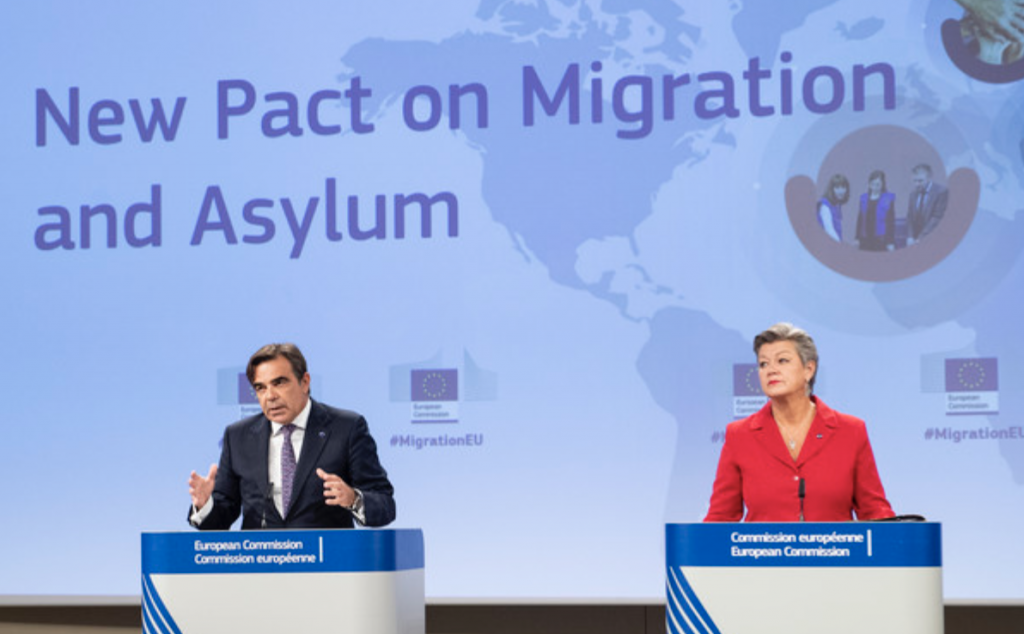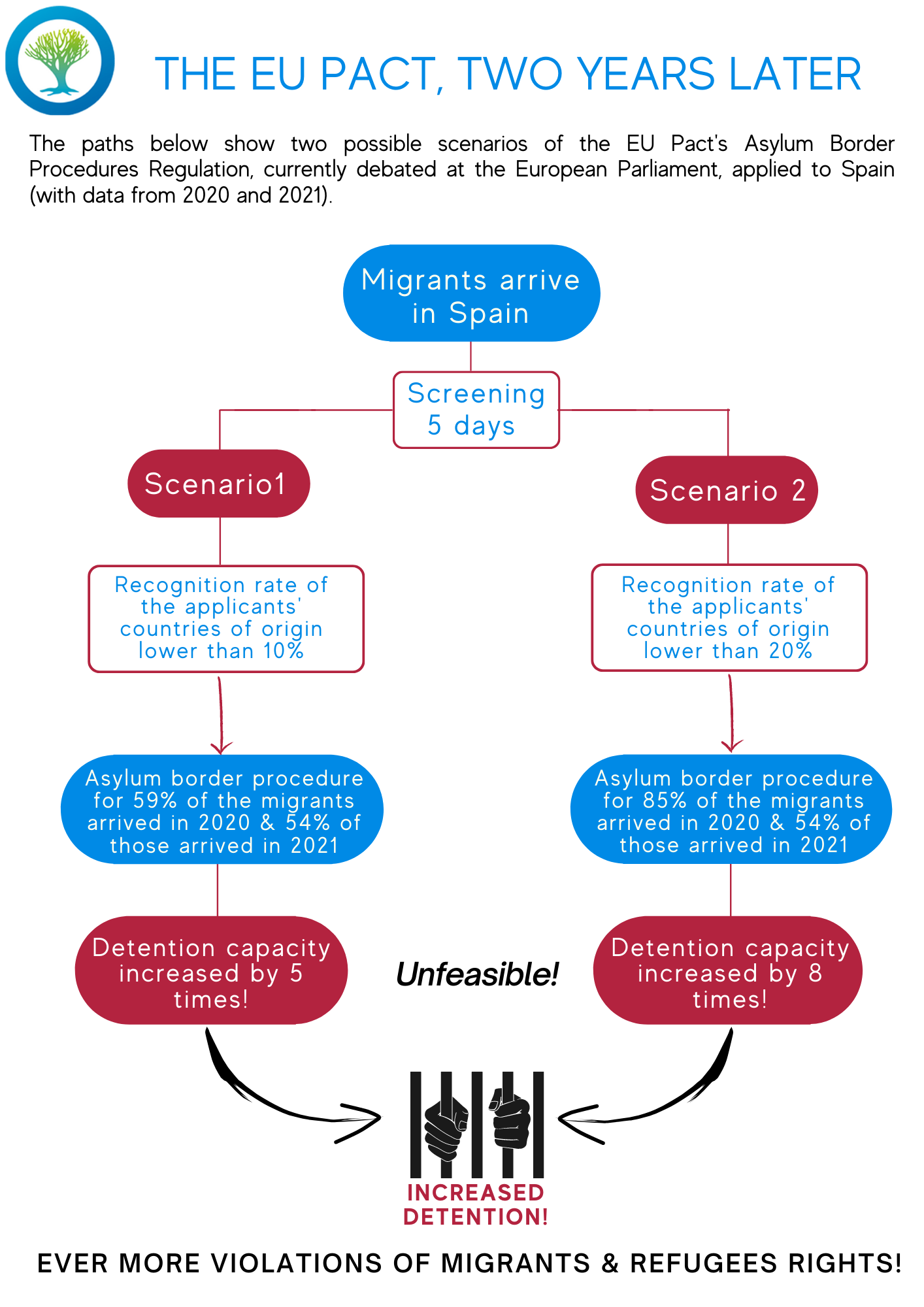This Friday 23 September marks two years since the European Commission issued the New Pact on Migration and Asylum.
Initially presented as a “fresh start” for European migration policy, the negotiations have not made much progress. In the meantime NGOs on the frontline have seen an increase in systematic pushbacks and more violence and deaths at the EU’s external borders. While not yet adopted, the capacities of the EU Pact also come under scrutiny in two new simulations presented by EuroMed Rights.
Violations at all borders…
In the Mediterranean, a record number of pushbacks by proxy were registered between Italy and Libya with 32,425 people returned to Libya in 2021 alone. Evidence of atrocious pushbacks at the Greek-Turkish borders have been adding up and came under scrutiny of the European Parliament. At the Spanish border, an unprecedented number of 4,404 deaths were registered in 2021 and recently 64 people went missing at the Nador-Melilla border.
Tragic events are on the rise in the Eastern Mediterranean, due to Malta’s, Greece’s and Italy’s non-assistance at sea. Cyprus’ systematic pushbacks policy is no better as evidenced by the recent death of a little girl, Lujii, after a 10-day journey in the Mediterranean. At the same time on 12 September 2022, a boat full of Syrians arrived at the Sicilian port of Pozzallo (apparently from Turkey) with the bodies of three dead children and three dead women on board.
Beyond the Mediterranean violent pushbacks also took place in 2021 at the border between Belarus, Poland and the Baltic countries. Thousands of people were massed in inhumane conditions. In the English Channel, the deadliest incident was registered in November 2021 when 27 people drowned. And yet, the UK government’s only response has been to externalise migration control to an extreme, via the UK-Rwanda deal. Pushbacks have also been on the rise in Bulgaria where hundreds of refugees, mostly from Syria, have been refouled to Turkey.
…while Member States and the EU lag behind
Meanwhile, the negotiations on the Pact have mostly been stalling but the EU Council has pushed for the approval of some single files rather than pursuing the “package approach” wanted by the European Parliament. Such an approach, which would require consensus from the EU Member States on all the legislative files of the EU Pact, is very difficult given the very divergent positions of EU Member States on certain provisions.
At the last Justice and Home Affairs meeting in June 2022, Member States reached an agreement on the Screening and Eurodac files which now have to be negotiated with the Parliament. Member States also agreed on the revised Schengen Borders Code, which includes a new broader and simplified definition of instrumentalisation of migration, following the events at the Belarus border, which would worryingly reduce migrants’ and refugees’ rights.
The Czech Republic, who is currently holding the rotating Presidency of the Council of the EU until the end of December 2022, is worryingly pushing for adopting a common position by the end of their Presidency on the Regulation addressing situations of instrumentalisation in the field of migration and asylum. While their proposal seems to have broad support from EU Member States it seriously infringes on migrants’ and refugees’ rights as it allows Member States to derogate from asylum laws and standards.
Finally, the European Parliament is negotiating amendments to the file on the asylum border procedure. One amendment proposed by the European Parliament is to reduce the percentage of recognition rate of the applicants’ countries of origin from 20% to 10%, meaning that any applicant who comes from a country that has a recognition rate of 10% or lower would automatically be directed to the border procedure. As the simulations carried out by EuroMed Rights (attached) show, an increasing number of migrants and refugees would still have to undergo the asylum border procedure in spite of the proposal.
The EU Pact on Migration cannot work
EuroMed Rights’ simulations show what would have happened in Spain and Italy in 2020 and 2021 if the Screening Regulation and the Asylum Procedures Regulation foreseen by the New Pact on Migration and Asylum were already in force.
The figures simulate two different scenarios. In the first one the recognition rate threshold for which the border procedures are applied is fixed at 20%, as provided by the original proposal in the Pact. In the second one, this threshold is fixed at 10% as foreseen by the amendments that are now discussed in the European Parliament.
The simulations show how a huge number of asylum seekers would still have to undergo the asylum border procedure, be deprived of their liberty and remain in detention for a prolonged period.
According to these simulations, Spain would have to increase its detention capacity by eight times in the 20% scenario and by five times in the 10% scenario. Italy would have to increase by 11 times its detention capacity in both scenarios. This shows the total unfeasibility of the proposal, even by lowering the threshold to 10%.
Eu Pact: still to be implemented and already outdated
Two years have passed since the EU Pact was presented by the Commission. During this time civil society organisations have witnessed an increase in violations against migrants and refugees across the region, ever more tragic incidents leading to further loss of lives, and a massive increase in derogations from asylum law and fundamental rights.
The negotiations around the EU Pact are mostly stalled, but the European Commission and Member States have proposed other provisions and legislative files, thus allowing Member States to reach swift agreements without having to agree on the whole EU “package”. One example is the Instrumentalisation Regulation which allows Member States to derogate from EU asylum law and guarantees. Some Member States have already started to implement some of the provisions contained in the EU Pact before it is adopted, thus circumventing the scrutiny role of the European Parliament.
How many years will migrants and refugees still have to wait before the EU and its Member States treat them as human beings and adapt their policies to offer a true “fresh start” based on human rights and respectful of migrants’ and refugees’ rights?


